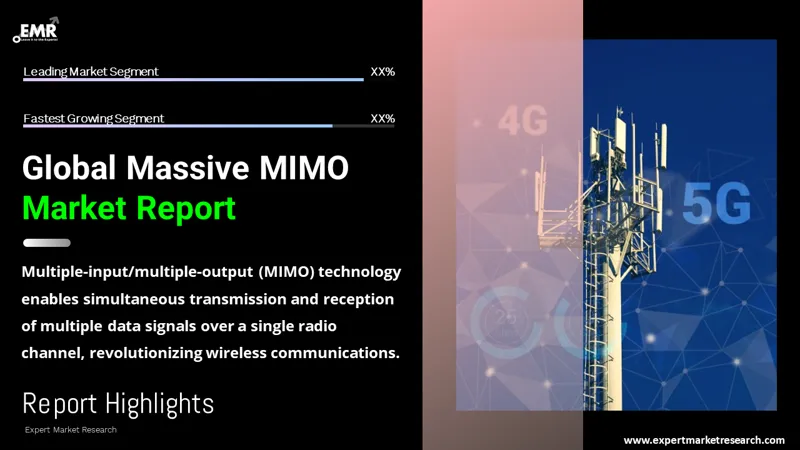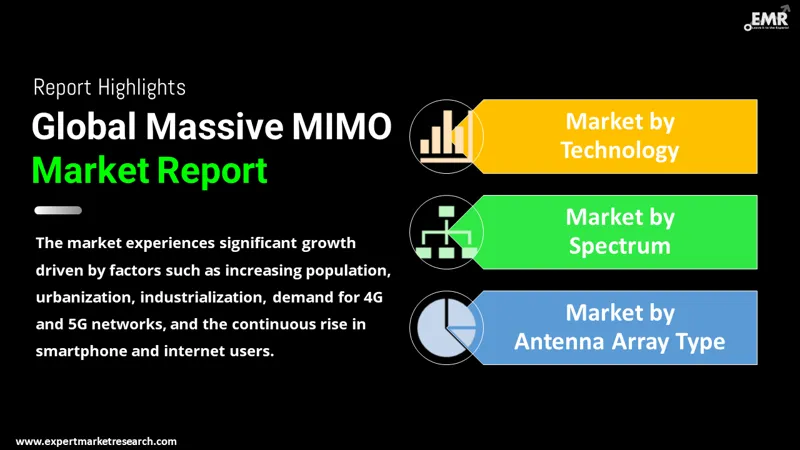
Consumer Insights
Uncover trends and behaviors shaping consumer choices today
Procurement Insights
Optimize your sourcing strategy with key market data
Industry Stats
Stay ahead with the latest trends and market analysis.
The global massive MIMO market attained a value of nearly USD 6.12 Billion in 2025. The market is further expected to grow in the forecast period of 2026-2035 at a CAGR of 34.00% to reach almost USD 114.24 Billion by 2035.
Base Year
Historical Period
Forecast Period
Compound Annual Growth Rate
34%
Value in USD Billion
2026-2035
*this image is indicative*
Over the forecast period, it is expected that the Asia Pacific will hold a healthy share in the market, with the regional market expected to witness a robust growth. The presence of key players in China has catalysed the market growth within the country, further propelling the development of the industry within the Asia Pacific region.

Read more about this report - REQUEST FREE SAMPLE COPY IN PDF
In 2017, Huawei and China Unicom, the major key players in China, completed the field verification of the industry’s first FDD LTE-based massive MIMO technology. Such developments have aided the growth of the market over the historical period. The region has also attracted heavy investments due to the increasing number of smartphone users, which has resulted in increased data sharing. This has further propelled the market growth of massive MIMO in the region.

Read more about this report - REQUEST FREE SAMPLE COPY IN PDF
Multiple-input/multiple-out (MIMO) is a technology that establishes wireless communications for sending and receiving multiple data signals simultaneously over the same radio channel. Massive multiple-input, multiple-output, or massive MIMO, is an extension of MIMO, whose key concept is to group antennas at the transmitter and receiver, which are used to serve many terminals simultaneously, at the same time-frequency resource, thus, providing a better spectrum efficiency and better throughput. The word “massive” is used to signify the number of antennas rather than the physical size. The “massive” number of antennas helps focus energy, resulting in drastic improvements in throughput and efficiency. It is available in 5G, in both sub-6 GHz and mm Wave bands. MIMO technology also plays a prominent role in Wi-Fi communications, and 3G, 4G, and 4G LTE networks.
Based on technology, the market can be segmented into:
The market can be broadly categorised on the basis of spectrum into:
The industry can be divided on the basis of antenna array type into:
The EMR report looks into the regional markets of massive MIMO like:
During the COVID-19 pandemic, as many industries witnessed a downfall, the massive MIMO industry witnessed a robust growth in demand. Owing to the lockdown measures amidst the pandemic, people have been spending more time on the internet. Work from home has also accelerated the demand for internet connections. Thus, the increase in the demand for high-speed internet from residential and business sectors and the rapid growth in data volume have been driving the massive MIMO industry growth.
The report presents a detailed analysis of the following key players in the global massive MIMO market, looking into their capacity, market shares, and latest developments like capacity expansions, plant turnarounds, and mergers and acquisitions:
The comprehensive report looks into the macro and micro aspects of the industry. The EMR report gives an in-depth insight into the market by providing a SWOT analysis as well as an analysis of Porter’s Five Forces model.




*While we strive to always give you current and accurate information, the numbers depicted on the website are indicative and may differ from the actual numbers in the main report. At Expert Market Research, we aim to bring you the latest insights and trends in the market. Using our analyses and forecasts, stakeholders can understand the market dynamics, navigate challenges, and capitalize on opportunities to make data-driven strategic decisions.*
Get in touch with us for a customized solution tailored to your unique requirements and save upto 35%!
In 2025, the global massive MIMO market attained a value of nearly USD 6.12 Billion.
The market is projected to grow at a CAGR of 34.00% between 2026 and 2035.
The market is estimated to witness a healthy growth in the forecast period of 2026-2035 to reach about USD 114.24 Billion by 2035.
Th major market drivers include rapid urbanisation and industrialisation, the rising demand for 4G and 5G networks, and the constant increase in the number of smartphones and internet users.
The key trends guiding the market growth are the increasing trend of remote work and the growing demand for high-speed internet from the residential and business sectors.
The major regions in the market are North America, Latin America, the Middle East and Africa, Europe, and the Asia Pacific.
LTE advance, LTE advance pro, and 5G are the major technologies considered in the market report.
TDD and FDD are the various segments based on spectrum of massive MIMO considered in the market report.
The major antenna array types included in the market report are 16T16R, 32T32R, and 64T64R, among others.
The major players in the market are Telefonaktiebolaget L M Ericsson, Huawei Technologies Co., Ltd., Nokia Corporation, Samsung Corporation, and ZTE Corporation, among others.
Explore our key highlights of the report and gain a concise overview of key findings, trends, and actionable insights that will empower your strategic decisions.
| REPORT FEATURES | DETAILS |
| Base Year | 2025 |
| Historical Period | 2019-2025 |
| Forecast Period | 2026-2035 |
| Scope of the Report |
Historical and Forecast Trends, Industry Drivers and Constraints, Historical and Forecast Market Analysis by Segment:
|
| Breakup by Technology |
|
| Breakup by Spectrum |
|
| Breakup by Antenna Array Type |
|
| Breakup by Region |
|
| Market Dynamics |
|
| Competitive Landscape |
|
| Companies Covered |
|
| Report Price and Purchase Option | Explore our purchase options that are best suited to your resources and industry needs. |
| Delivery Format | Delivered as an attached PDF and Excel through email, with an option of receiving an editable PPT, according to the purchase option. |
Single User License
One User
USD 3,999
USD 3,599
tax inclusive*
Datasheet
One User
USD 2,499
USD 2,249
tax inclusive*
Five User License
Five User
USD 4,999
USD 4,249
tax inclusive*
Corporate License
Unlimited Users
USD 5,999
USD 5,099
tax inclusive*
*Please note that the prices mentioned below are starting prices for each bundle type. Kindly contact our team for further details.*
Flash Bundle
Small Business Bundle
Growth Bundle
Enterprise Bundle
*Please note that the prices mentioned below are starting prices for each bundle type. Kindly contact our team for further details.*
Flash Bundle
Number of Reports: 3
20%
tax inclusive*
Small Business Bundle
Number of Reports: 5
25%
tax inclusive*
Growth Bundle
Number of Reports: 8
30%
tax inclusive*
Enterprise Bundle
Number of Reports: 10
35%
tax inclusive*
How To Order

Select License Type
Choose the right license for your needs and access rights.

Click on ‘Buy Now’
Add the report to your cart with one click and proceed to register.

Select Mode of Payment
Choose a payment option for a secure checkout. You will be redirected accordingly.
Gain insights to stay ahead and seize opportunities.

Get insights & trends for a competitive edge.

Track prices with detailed trend reports.

Analyse trade data for supply chain insights.

Leverage cost reports for smart savings

Enhance supply chain with partnerships.

Connect For More Information
Our expert team of analysts will offer full support and resolve any queries regarding the report, before and after the purchase.
Our expert team of analysts will offer full support and resolve any queries regarding the report, before and after the purchase.
We employ meticulous research methods, blending advanced analytics and expert insights to deliver accurate, actionable industry intelligence, staying ahead of competitors.
Our skilled analysts offer unparalleled competitive advantage with detailed insights on current and emerging markets, ensuring your strategic edge.
We offer an in-depth yet simplified presentation of industry insights and analysis to meet your specific requirements effectively.
Share